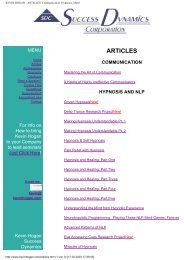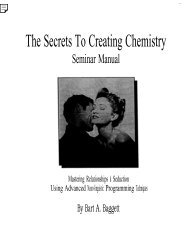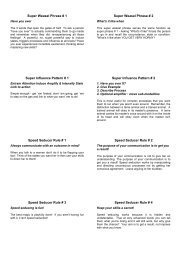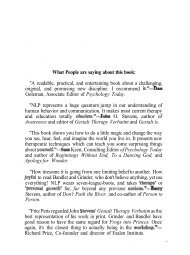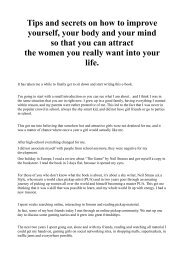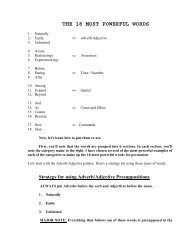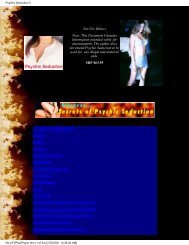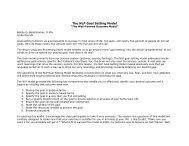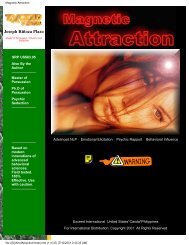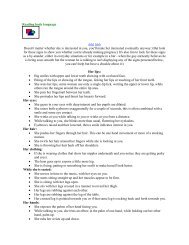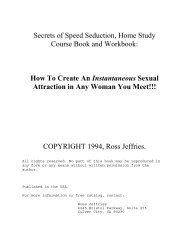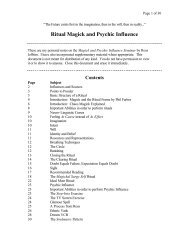A Pragmatic Guide To Communication & Change.pdf - NLP Info Centre
A Pragmatic Guide To Communication & Change.pdf - NLP Info Centre
A Pragmatic Guide To Communication & Change.pdf - NLP Info Centre
- No tags were found...
Create successful ePaper yourself
Turn your PDF publications into a flip-book with our unique Google optimized e-Paper software.
ecause it allows the speaker/writer to share a great deal of information rapidly without<br />
needing to fill in all the missing pieces. However, the same process may drastically limit<br />
the speaker's ability to express what he really means. A person's language can also<br />
indicate areas where he has limits on his ability to perceive the full richness of certain<br />
experiences. The result of such limitations and distortions may be that the speaker has<br />
few choices about how to feel or behave in certain situations.<br />
Meta Model Responses<br />
What the Meta Model does is make explicit those semantic and syntactic contexts, those<br />
expressions in which Meta Model violations occur. Once they can be systematically<br />
recognized, there are specific Meta Model responses which you can use to recover deleted<br />
material and to assist the speaker in reconnecting with his deep structure. Reconnect ing<br />
with the fullest linguistic representation of a person's experience can aid him in<br />
understanding how certain generalizations, deletions and distortions cause pain and limit<br />
choice and perception. This paves the way for healthy growth and positive change.<br />
The Meta Model is a set of eight linguistic distinctions which can be grouped into three<br />
categories. The first category, Gathering <strong>Info</strong>rmation, begins the process of uncovering<br />
and exploring specific portions of the speaker's experience which are missing from his<br />
surface structure or which are presented in a distorted form. The second category,<br />
Expanding Limits, provides you with tools to assist the speaker in defining and then<br />
expanding the boundaries or limitations of his model of the world. This self exploration<br />
assists the speaker in gaining more choices in both behavior and perception. The final<br />
category, Changing Meanings, continues the process of growth and expansion by<br />
exploring with the speaker how he understands himself and his relationship with the<br />
people around him and with the world in general.<br />
Meta Model Diagram k1<br />
The deep structure is the most complete linguistic representation that a person<br />
could give to experience. This is symbolized by the larger form below. The deep<br />
structure includes the boundary line and all the space contained within it.<br />
The surface structure is the portion of the deep structure expressed by an<br />
individual when he speaks or writes. It is represented by the shaded portion of the<br />
larger form. Notice in the illustration below how the "shape" of the SS conforms<br />
to the "shape" of the DS. Since the transformational processes of creating the SS<br />
from the US are essentially the same as the processes we use to create our models<br />
of reality, the SS is an invaluable indicator of how the speaker perceives the world<br />
around him. It is through the SS that we gain clues about the rest of the speaker's<br />
model. With the aid of the first category of Meta Model responses to violations,<br />
we gain more information about the unshaded portion of the model below, the DS.<br />
soagnct: sTUUOTCRE<br />
I highly recommend that anyone learning the Meta Model read over this section carefully<br />
in order to get the general feel and logic of the model. Then go back to the beginning_<br />
and start with the first distinction. Attuning yourself to each distinction, hearing it when it<br />
comes up, and being able to<br />
72<br />
Linguistic Deconditioning<br />
Taking their understanding one step further, Dr. Palazzoli and her colleagues began to



